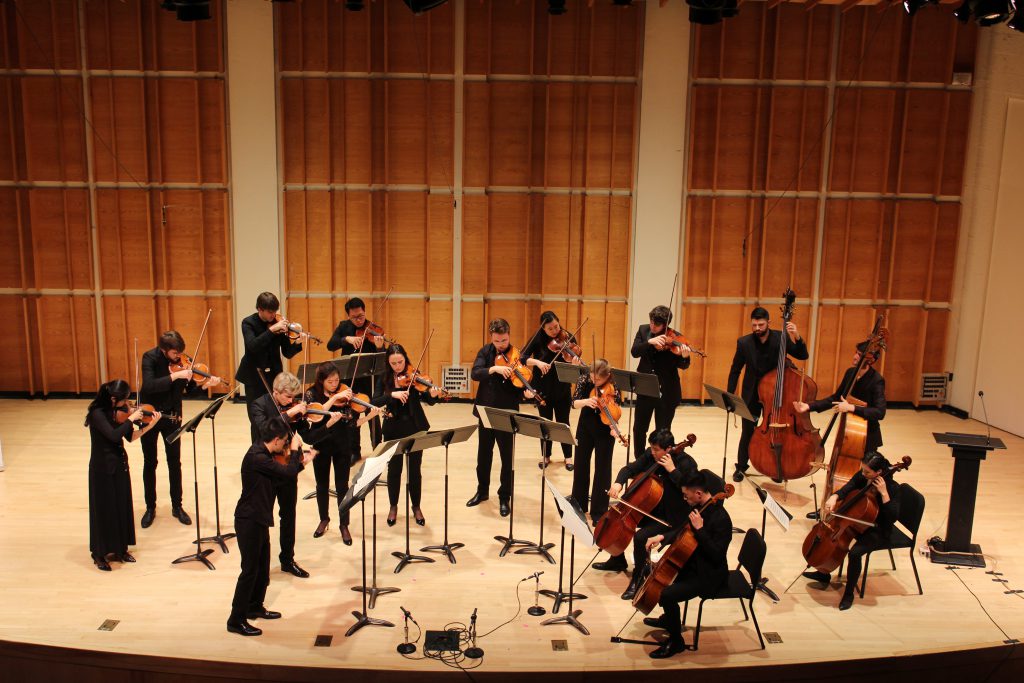Doing good by playing well, Versoi Ensemble makes an auspicious debut

The Versoi Ensemble made its debut Tuesday night at Merkin Concert hall. Photo: Cecilia Yao
Versoi Ensemble, a socially-minded group of string players who aim to do good by playing well, showed on Tuesday night that it was well on the way to the latter goal, at least.
Making its world debut at Merkin Concert Hall, the ensemble, consisting of students and recent alumni of New York’s Juilliard School and the Sibelius Academy in Helsinki, performed works for strings by Sibelius, Dvořák, Esa-Pekka Salonen and Elgar with vigor, precision and a sure instinct for the give-and-take of chamber music.
Versoi also unveiled, in the printed program and in remarks by its executive director Mosa Tsay, a vision of itself fostering “a cultural exchange as well as joint advocacy of human rights” by playing concerts in support of humanitarian causes, starting with a food-assistance program in Sarasota, Florida.
That social mission may still be in the works, but on Tuesday night there was no denying the clear-and-present fact of fine playing on Merkin’s stage.
The ensemble, whose name means “sprouted” in Finnish, grew out of a summer orchestral workshop in 2017 sponsored by the two famous music schools. A let’s-keep-doing-this urge is common on such occasions and often leads nowhere; but in this case the two conservatory orchestras joined forces, under conductor Salonen’s direction, for a brief international tour in celebration of the 100th anniversary of Finnish independence.
Relationships formed in New York and on the road led to the idea of a music-and-good-works project, which made its bow Tuesday night. Limiting himself to a few words of praise from the stage, Salonen looked on from a seat in the house as the group of 19 musicians demonstrated near-flawless ensemble playing in Sibelius’s Romance for String Orchestra, Op. 42—“like fish swimming in perfect formation,” the conductor said.
In the characteristically dark-hued Sibelius andante, one was aware not so much of feats of coordination as of a wonderfully robust string sound and a sense of long melodic line, occasionally ruffled by bits of dance rhythm, as the players of various nationalities got with the Finnish program.
Five players designated on the roster as “core” members of the group performed the concert’s next two items, Dvořák’s String Quintet in E-flat major, Op. 97, and Salonen’s Homunculus for String Quartet (composed in 2007).
Youthful vitality will get you far in Dvořák’s charming chamber music. In addition to that, the players—Max Tan and Johannes Hakulinen, violins; Bethany Hargreaves and Max Nyman, violas; and Matthew Chen, cello—brought to the work finely shaped phrases, gradations of light and shade (especially in the first movement’s development), and a keen ear for which lines to feature in the ensemble texture.
The scherzo-like second movement had plenty of drive but never sounded rushed, and Hargreave’s viola solo in the trio brought out the tune’s almost Asiatic flavor.
The group’s inexperience as an ensemble began to show a little in the Larghetto, whose five variations, though well-executed, needed more contrast in character. Similarly, the group didn’t do much with the puckish humor of the rondo finale, whose trivial little theme returns each time preceded by ever-grander preparations. One could imagine the Czech master chuckling over his score, and a laugh or two on Tuesday wouldn’t have done any harm.
On his website, Salonen describes Homunculus as “a small piece that behaves like a big piece,” that is, with a lot of contrast and incident squeezed into a 12-minute frame. The title derives from the ancient theory that every human individual begins life as a tiny, complete person (homunculus), different from an adult only in size, an idea the composer found “strangely moving.”
That image also evoked the rock-and-Rite style that has produced some of this composer’s most compelling music, combining Dionysian energy with sudden, barbaric contrasts. Tuesday’s quartet, consisting of Tan, Hakulinen, Nyman and Chen, bravely rode the wave from the slashing opening bars to mysterious solos in the haze to long ecstatic crescendos in dense harmonies. The players’ sense of tone color and close listening to each other served them especially well here.
The full ensemble returned for Elgar’s Introduction and Allegro, Op. 47, opening the piece with a vibrant forte that shook the small hall to its foundations. The piece, composed in 1905 to show off the skills of the newly-formed London Symphony Orchestra, nominally features a solo string quartet in concerto grosso style, but in reality gives all the players plenty to do.
Playing standing up (except the cellos), the Versoi musicians put their backs and bows into the music, sonorously shaping and swelling the Introduction’s phrases, and making the Allegro scintillate with Elgar’s quirky humor and sudden bursts of song.
If imagination flagged a bit during the “devil of a fugue,” as the composer called it, and in the work’s closing pages, one can attribute that to an ensemble still finding its voice, musically and in the world at large.
As for the Versoi Ensemble’s humanitarian vision, the idea of “giving back” isn’t usually associated with aspiring young artists to whom society hasn’t yet “given” very much. But the caliber of playing on Tuesday night suggested that this group of debutantes may soon have some serious fame to lend to a worthy cause.